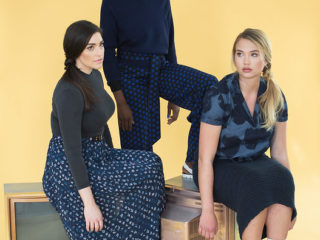Most of us have taken a look at our closet at some point in time and felt guilt about the amount of clothing we’ve accumulated. Most of us have also acknowledged the need to donate. While it seems easy to simply drop our clothing off at a Salvation Army or Goodwill, what many don’t know is how easily that can actually equate to throwing our clothing away.
Here are the facts about textile waste.
According to the United States Environment Protection Agency textiles as a category, have one of the lowest recycling rates of any reusable material. And when recycled, only 10% of those textiles are considered re-usable. That means about 90% are either sent to landfills or flood markets in developing countries. Each year in America alone, 10.5 million tons of clothing are sent to a landfill. That’s 31,250 tons everyday, 218,750 tons each week, and 875,000 tons each month. To clarify that’s a terrifying 62.5 mill. pounds of clothing a day headed to a landfill.
As we mention above, donating to some government-run charities like The Salvation Army and Goodwill may not be the most effective way to recycle our clothes. Although these charities stood as our nation’s go-to textile recyclers since the early 20th century with bins for donations appearing as early as the 1940s, this system was established in a pre-consumerist America, before fast fashion reigned our wallets and before our current waste crisis came to exist.

Over the past decade, the amount of clothing Americans purchase has tripled 400%. And between 1999 and 2009, the volume of textile trash rose by 40 percent. Because of this, the bins that initially started out as an effective recycling method have transformed charities into dumps that accept clothes of varying condition in ever-increasing volumes.
As Jackie King, executive director of the Secondhand Materials and Recycled Textiles Association (a trade group) states, “People think that when they are giving to, say, a Salvation Army or Goodwill, that all of that is going to be resold in their stores, and it’s just not, because they don’t have enough room for that.” Instead, these charities sell only about 10% of what they receive in their retail shops. That means that most of our clothing is simply going to the trash bin we walked past on our way to the neighborhood Goodwill.
While it will take some time to find a real solution to the entirety of the waste issue, we, as tenants of this environment, can do our part in alleviating the situation by collectively changing the direction in which we send our clothes. Instead of finding an easy fix to get rid of your old clothing, look for organizations that are honest in what they say they do with your donations. And only donate items that have potential for a second life – no holes, no stains, no tears. Be considerate of the next person wearing your clothing.
Instead of finding an easy fix to drop your bag of clothing, look for organizations that are honest in what they say they do with your donations.
Here are some places you can safely and consciously give to, knowing that the majority of your clothing will find a useful home:
Dress for Success: A non-profit that focuses on the empowerment of women looking to go back into the workforce – focusing on suiting and styling them with appropriate interview attire
Refashion NYC: In partnership with Housing Works, Refashion NYC uses donations and profits from donations to fund a full range of lifesaving services for homeless and low income men, women, and youth living with HIV and AIDS, including housing, medical care, job training and other supportive services.
You can also always donate to local homeless or battered women’s shelters. Donating to local organizations is safer because there is no middleman or complicated distribution process. You can always take the clothes to the front door and talk to someone directly.
Know of other great clothing donation resources? Let us know in the comments!
Images via Monica Outcalt












17 comments
Our local Goodwill has a clothing fiber recycling program than is able to reuse fabric that would otherwise fill a landfill. Not all clothing charities do this, and it’s worth checking into.
I also liked this article which shares which thrift store is non-profit or for-profit, and how they use the money. https://m.mic.com/articles/138502/this-is-where-your-thrift-store-dollars-are-really-going/
I found this article interesting but ultimately not very helpful in terms of practical actions I can take to deal with my own growing pile of donation clothing.
Most of what I have wouldn’t be acceptable for donations (most are picky because they don’t want to become dumping grounds for stained, torn, poorly made garments–understandable).
So what to do with all my less than perfect items? Throwing things in the garbage feels wasteful and the idea of my clothes sitting in a landfill is depressing.
It seems to me there are two real issues which need to be addressed in a creative way:
1. A shift in values in which we are buying less (and perhaps focusing on consumables that are more durable as well as recyclable). This also requires businesses which design, manufacture, and sell clothes (along with other consumer goods) to adopt very different business models.
2. Expanding the infrastructure when it comes to recycling textiles. There are a lot of small, artistic concerns that incorporate unwanted clothes in “refashioned” “reused” etc. This is great but they are addressing a tiny proportion of the ever growing supply.
I’d love to see clothing becoming incorporating in mainstream manufacturing processes: Papermaking is one that comes to mind but I’m sure there are lots of other uses for textiles. The issues here are manufacturing processes and economics.
I am a great believer in human talent. People can be amazing when it comes to devising innovative solutions in which everyone wins. I think encouragement by leaders, activists, and influencers could begin creating momentum for these solutions.
I would love to learn more about people and organizations who are leading the way in terms of reducing consumption as well as creatively finding uses for clothes which aren’t suitable for donation.
I think H&M being brought into the conversation is a good example of the root of this problem. We are buying WAY too much cheap clothing. No matter how you decide to get rid of it, if it wasn’t a good purchase it’s doing more harm than good. H&M likes talking about how much they’re doing to be green but historically they’ve treated their workers like crap and no amount of ‘recycling’ can make that go away.
I appreciate Darling sharing about this topic we need to keep having hard conversations about the way we consume.
Hey There, appreciate the efforts you took in creating this article but I’m not sure you’re preaching in a positive direction. Donating clothing is a positive action, but the problem we’re facing is most women are wearing their clothing between one and three times and buying things on a whim (read the study Bernard’s put out on the subject, it’s very interesting/terrifying https://www.barnardos.org.uk/news/media_centre/Once-worn-thrice-shy-8211-British-women8217s-wardrobe-habits-exposed/press_releases.htm?ref=105244) from cheaply made, ecologically unfriendly and ethically horrific brands (Your H&Ms get no bonus points). The Salvation Army and Good Will ARE appropriate places to donate your clothing, they’re NOT GOVERNMENT RUN – that was an email scam https://www.goodwill.org/uncategorized/think-before-you-donate-and-get-the-facts-about-email-rumors/ – I think it is really important that when you’re writing on subjects like these you fact check your information with at least two reliable sources that way there is less of a chance of you making mistakes and accidentally influencing people in a negative direction. I appreciate your work on this piece but would love to see it expanded and better researched and maybe include some ideas for women to shop for clothing that is made ecologically and ethically – or at the very least made to last – so we can all help this system run smoother. Wishing you a lovely day! x
If you really want to learn about this issue, I recommend three books for you, written by academics who have researched it extensively: Clothing Poverty by Andrew Brooks, The Journey of a T-Shirt by Pietra Rivoli, and Salaula by Karen Hansen. If you don’t have time to read them, here is the short version. All donated clothing goes to the same place, no matter where you donate it. It’s put to its best use, either resold as high-end used, resold in global markets as low-end used, recycled into new textiles, cut up into rags, or shredded into stuffing or insulation. It matters where you donate only inasmuch that you want a particular charity to get the proceeds from reselling your items, so think of donating clothing like donating cash, instead of donating stuff that poor people will get. The United States consumer goes through so much clothing, there is no way we could ever handle all of it here in the US, ever. And while there is disagreement on its economic effect on developing countries (some think it’s positive, some think it’s negative) there is nothing you can do to keep it from going there once it is out of your hands. So donate away, and if you really want to make a difference, then buy higher quality garments to begin with, instead of disposable fast fashion.
Thanks for writing this Janet! This is a fascinating article. I was wondering if you would be okay with people creating for-profit solution to clothing waste if they disclosed the for-profit nature of what they were doing with clothing donations, or providing donors with some tax break, or personal remonetization?
Adam Braun, the founder of Pencils of Promise, uses the term “for-purpose” to describe companies that are profitable, but with a non-profit approach, and I think the “for-purpose” approach is necessary to address the billions of pounds of clothing getting trashed every year!
Hi Lydia,
Glad you enjoyed the article!
There’s nothing wrong with profiting while creating solutions, as long as that’s the truth and the company can clearly outline how that’s happening. I think it only becomes an issue if 1) a company exploits the concept of aiding a problem and uses it as a marketing mask for the purpose of profit or 2) a company gets lost in the profitable aspect along the way and loses its focus on aiding.
A “for purpose” approach could work for the issue of textile waste, as long as the company exerted equal efforts to resell goods as well as find the best sorting system to send off the goods they couldn’t. These two elements should go hand-in-hand.
Thanks for your thoughtfulness above Leah, I agree. I would also like to introduce the idea of extending the life of your clothes (through mending and up-cycling) as part of the equation. I think that so much of the textile waste we produce is due to the premature discarding of flawed garments (ones that cannot be resold). We need to focus more on preserving rather than replacing. Even those things which are not mendable can be turned into rags for around the house at the very least.
Embrace mending and reuse as radical acts of anti-consumerism!
Hi Trinity,
You’re absolutely right! Preserving rather than replacing/consuming more is definitely a step you can take to eliminate waste. Consuming less is most definitely a huge step in preserving our earth.
This is well researched, but I don’t think the distinction at the end makes much sense. While you do encourage donors to give only the best quality clothing (which is helpful), it’s simply not true that local thrift shops necessarily resell more of what comes in than a larger thrift shop franchise would. It totally depends on the quality and re-sale potential of the particular item during the particular season and according to the shop’s demographics.
And then there’s still the question of what to do with the things that didn’t make the cut in the first place. What can a consumer do with garments that aren’t high enough quality to be re-sold? In most cases, their best option is to give to a thrift shop that will pass them on to textiles re-processers, because their only other option is to throw their old things out.
The actual solution is to consume less in the first place and to shop secondhand when you need something. That’s the most important part of the conversation and it’s missing from this article
Sincerely, a thrift shop manager
Hi Leah,
The issue of textile waste is a complex one, and while you’re absolutely right about us consuming less, the below article, based on the documentary The True Cost, is more specific in covering that aspect:
https://blog.darlingmagazine.org/where-do-your-clothes-come-from-a-true-cost-qa/
This article here is to encourage ourselves to look into the channels that we donate through. Donating will always be a part of recycling, so it’s good to educate ourselves about this step before we do so. The article never states that smaller thrift shops sell more than larger thrift shops do – when we say “donating to local organizations,” we are referring to non-profit organizations (like local homeless or battered women’s shelters) or even clothing drives that are constantly looking for specific items. It may not be as convenient for us, but it’s effective and part of our responsibility to seek these places out. Unfortunately there isn’t one resolution to the waste issue, so understanding all the areas in which it affects is a healthy way to approach it.
Hi. I’ve watched The True Cost and can’t argue with the complexity of the clothing and consumer goods life cycle. But the fact of the matter is that even donating to homeless shelters and clothing drives – which, I might add, is very rarely significantly more difficult to seek out than the local thrift shop – will not guarantee the item a good home. Speaking as a thrift shop manager, I would also add that we work with local service agencies to ensure that local, low income community members get exactly what they need; we also pass things on to charities and organizations who could find a better use for them, so it’s not simply an either-or issue.
The problem is that we get rid of such a large quantity of goods that there is nowhere to put all of it.
Unfortunately, I hear the argument all too often that even not-so-good things can be used by poor or homeless people when the reality is that we have so many nice things on the secondhand market to offer up to charities that there is no reason to not give the very best. I know you’re not making that argument here, but it seems that we must still address the fact that, at the end of the day, we could distribute clothing to everyone on earth and still have things left over.
It’s not that I don’t “get” the article, it’s that the resolution doesn’t really resolve anything.
Leah, this topic is one that I’ve been thinking about for about a year now, and I’m glad to see this discussion. A question for you as a thrift shop manager: How can thrift shops increase the demand for secondhand clothes? And second, how do thrift shops decide what to put out for sale?
Hi! Thanks for your questions.
I think we still need to work on undermining the stigma that secondhand = used and gross. For some in my somewhat traditional community, thrift shops are still seen as a place where only poor people go. There are a lot of problems with that argument (like the fact that it’s classist), but I think that we can create spaces that are welcoming to people no matter where they come from. For my part, I’m trying to make sure that the thrift shop I manage is clean, well maintained, and that our volunteer staff is knowledgeable about brands while keeping our prices low and offering resources to people in need. It’s a tough balance to get just right, but I believe very much in the potential of thrift shops to be community centers. Bragging about the great things you find at the thrift shop to your friends is also very helpful.
Many people don’t prefer thrift shops because they feel like they’ll have to go on a hunt for the thing they want instead of pulling it straight from the rack. Maybe thrift shops can move toward specializing in particular items over time, but for now I think properly labeling and organizing products is a huge help, and one a lot of shops haven’t caught on to.
We decide what to put out based on space, quality of materials, current condition, and brand. At my shop, we don’t carry a lot of vintage because we don’t have the younger market for it. We have figured out over time that classic brands like Chico’s do well. We also don’t carry WalMart brands simply because their original purchase price is nearly equivalent to our standard resale price. In a way, we’re not so different from a standard store. We sell what the market wants and don’t store a lot of knick knacks or imperfect items because they distract from the nicer things. If we can’t sell it, we pass it on to AMVETS for textiles reprocessing.
Leah I love your input on this issue. It’s great to hear a thrift shop owners perspective. I’ve also heard and read that major chain thrift stores donate what they can’t use for recycling. I’m wondering if you or anyone else knows of a source that has confirmed a list of who sends the unsold textiles to be recycled and who just throws it away so we know who to support. The trouble with the idea of repurposing as rags etc. is that we only need so many rags, and eventually those too will be tossed out. I’m eager for a solution that allows the common consumer to easily and confidently donate soiled clothing ( and from a sewers point of you – fabric scraps! ) to a company that will break down and recycle or re-use every bit of it.
I recently noticed that H&M accepts any type, condition, and brand of clothing and home textiles to be recycled. You can drop the items off in their stores for free.
Hi Amy,
Yes, H&M has launched what they call their own Garment Collecting service! Although it’s definitely a convenient drop-off option and the company is saying they’re rewearing, reusing, and recycling the clothes, there doesn’t seem to be too much information on exactly how they’re doing that. A lot of companies will claim a non-profit approach when collecting used garments, but in actuality, their focus is profiting from the garments and not actively finding ways to eliminate the waste that can’t be profited from.